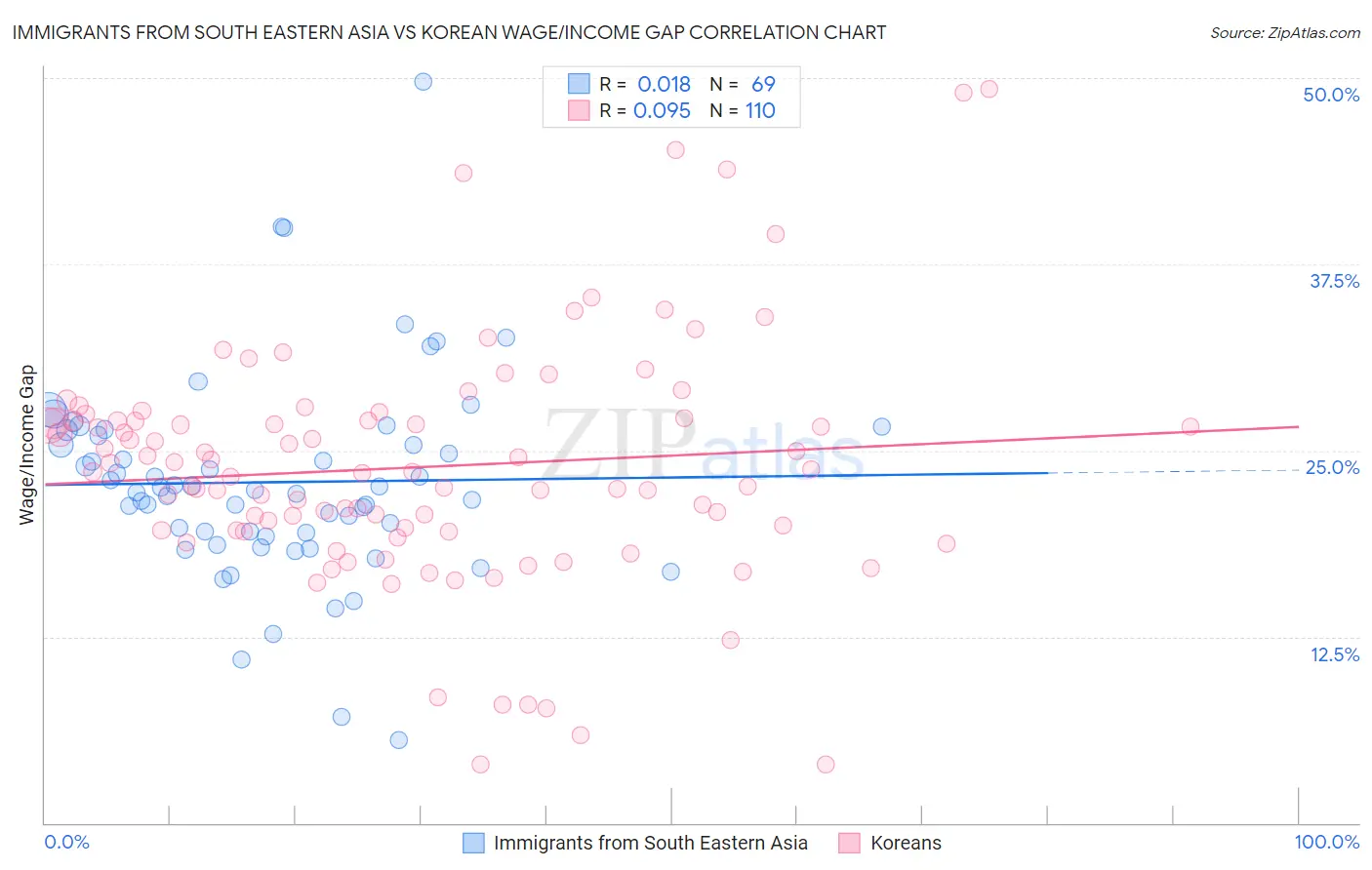Immigrants from South Eastern Asia vs Korean Wage/Income Gap
COMPARE
Immigrants from South Eastern Asia
Korean
Wage/Income Gap
Wage/Income Gap Comparison
Immigrants from South Eastern Asia
Koreans
24.8%
WAGE/INCOME GAP
90.9/ 100
METRIC RATING
137th/ 347
METRIC RANK
25.4%
WAGE/INCOME GAP
68.6/ 100
METRIC RATING
164th/ 347
METRIC RANK
Immigrants from South Eastern Asia vs Korean Wage/Income Gap Correlation Chart
The statistical analysis conducted on geographies consisting of 511,945,598 people shows no correlation between the proportion of Immigrants from South Eastern Asia and wage/income gap percentage in the United States with a correlation coefficient (R) of 0.018 and weighted average of 24.8%. Similarly, the statistical analysis conducted on geographies consisting of 510,260,978 people shows a slight positive correlation between the proportion of Koreans and wage/income gap percentage in the United States with a correlation coefficient (R) of 0.095 and weighted average of 25.4%, a difference of 2.6%.

Wage/Income Gap Correlation Summary
| Measurement | Immigrants from South Eastern Asia | Korean |
| Minimum | 5.6% | 3.9% |
| Maximum | 49.7% | 49.3% |
| Range | 44.2% | 45.4% |
| Mean | 22.9% | 23.9% |
| Median | 22.3% | 23.6% |
| Interquartile 25% (IQ1) | 19.4% | 19.6% |
| Interquartile 75% (IQ3) | 26.2% | 27.0% |
| Interquartile Range (IQR) | 6.8% | 7.4% |
| Standard Deviation (Sample) | 6.9% | 8.1% |
| Standard Deviation (Population) | 6.8% | 8.1% |
Similar Demographics by Wage/Income Gap
Demographics Similar to Immigrants from South Eastern Asia by Wage/Income Gap
In terms of wage/income gap, the demographic groups most similar to Immigrants from South Eastern Asia are Armenian (24.8%, a difference of 0.080%), Immigrants from Bosnia and Herzegovina (24.8%, a difference of 0.16%), South American Indian (24.7%, a difference of 0.23%), Hispanic or Latino (24.9%, a difference of 0.27%), and Mexican American Indian (24.7%, a difference of 0.28%).
| Demographics | Rating | Rank | Wage/Income Gap |
| Alsatians | 93.2 /100 | #130 | Exceptional 24.7% |
| Immigrants | Philippines | 93.0 /100 | #131 | Exceptional 24.7% |
| Immigrants | Costa Rica | 92.4 /100 | #132 | Exceptional 24.7% |
| Colombians | 92.4 /100 | #133 | Exceptional 24.7% |
| Mexican American Indians | 92.2 /100 | #134 | Exceptional 24.7% |
| South American Indians | 92.0 /100 | #135 | Exceptional 24.7% |
| Armenians | 91.3 /100 | #136 | Exceptional 24.8% |
| Immigrants | South Eastern Asia | 90.9 /100 | #137 | Exceptional 24.8% |
| Immigrants | Bosnia and Herzegovina | 90.1 /100 | #138 | Exceptional 24.8% |
| Hispanics or Latinos | 89.5 /100 | #139 | Excellent 24.9% |
| Immigrants | Nepal | 89.3 /100 | #140 | Excellent 24.9% |
| Hawaiians | 89.3 /100 | #141 | Excellent 24.9% |
| Afghans | 88.1 /100 | #142 | Excellent 24.9% |
| Immigrants | Uganda | 88.0 /100 | #143 | Excellent 24.9% |
| Chippewa | 86.9 /100 | #144 | Excellent 25.0% |
Demographics Similar to Koreans by Wage/Income Gap
In terms of wage/income gap, the demographic groups most similar to Koreans are Native Hawaiian (25.4%, a difference of 0.030%), Shoshone (25.4%, a difference of 0.040%), Albanian (25.4%, a difference of 0.060%), French American Indian (25.4%, a difference of 0.32%), and Immigrants from Hong Kong (25.5%, a difference of 0.34%).
| Demographics | Rating | Rank | Wage/Income Gap |
| Costa Ricans | 75.8 /100 | #157 | Good 25.3% |
| Immigrants | Zimbabwe | 73.7 /100 | #158 | Good 25.3% |
| Puget Sound Salish | 73.0 /100 | #159 | Good 25.3% |
| French American Indians | 72.5 /100 | #160 | Good 25.4% |
| Albanians | 69.4 /100 | #161 | Good 25.4% |
| Shoshone | 69.0 /100 | #162 | Good 25.4% |
| Native Hawaiians | 69.0 /100 | #163 | Good 25.4% |
| Koreans | 68.6 /100 | #164 | Good 25.4% |
| Immigrants | Hong Kong | 64.0 /100 | #165 | Good 25.5% |
| Immigrants | Ukraine | 63.8 /100 | #166 | Good 25.5% |
| Paiute | 62.9 /100 | #167 | Good 25.5% |
| Seminole | 62.6 /100 | #168 | Good 25.6% |
| Peruvians | 60.1 /100 | #169 | Good 25.6% |
| Immigrants | Oceania | 57.5 /100 | #170 | Average 25.6% |
| Immigrants | Greece | 56.6 /100 | #171 | Average 25.7% |